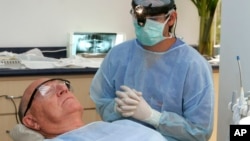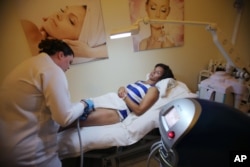The recent kidnapping of four Americans in Mexico brought attention to a common practice for many people in the United States: medical tourism.
Medical tourism is traveling to other countries to receive medical care that is not available or too costly at home.
The four Americans were caught in a shootout between criminal drug organizations. Two were killed and two were held in a remote area of Mexico. A family member said the four were on a trip from the U.S. so that one of them could get cosmetic surgery from a doctor in Matamoros.
Experts say people leave the U.S. to get many medical procedures. These include cosmetic surgery, dental care, cancer treatments and buying medicines.
Medical tourism growing
Lydia Gan is an economist at the University of North Carolina at Pembroke. She said medical tourism has been growing in popularity for years.
This kind of travel is popular with people who have no health insurance or health plans that require them to pay thousands of dollars in additional costs. Sometimes, companies send people covered by their insurance to other countries for medical procedures like hip or knee replacements. Some companies also send people to Mexico for less costly medicines.
Jonathan Edelheit is head of the Medical Tourism Association, an industry trade group. He told the Associated Press that medical care costs in countries like Mexico can be more than 50 percent lower than in the U.S. Also, cosmetic surgeries that cost thousands of dollars are largely not covered by U.S. health insurers.
Patients sometimes travel because they can get quick care outside the U.S. They also might want to seek treatment from a doctor who speaks their language or comes from the same culture.
Medical Tourism Magazine, the trade group’s publication, said over $37 billion was spent on medical tourism in 2019 around the world. Besides Mexico, the publication said the top five countries for medical tourism are Canada, Singapore, Japan, Spain, and Britain. Other places include Dubai, Costa Rica, Israel, Abu Dhabi, and India.
In 2019, the city-state of Singapore received more than 500,000 foreign visitors for its less costly and high-quality healthcare. For example, heart bypass surgery could cost $140,000 in the U.S. compared to $25,000 in Singapore. In Spain, the average cost of cosmetic surgery such as a face lift could be $5,000 instead of $15,000 in the U.S.
Risks of medical tourism
The U.S. Centers for Disease Control and Prevention (or CDC) says millions of people from the U.S. travel to other countries for care each year.
Researcher Arturo Bustamante estimates that 400,000 people traveled from the U.S. to Mexico each year for care before COVID-19 appeared. The University of California, Los Angeles health policy professor said most of the people visiting Mexico for care are Mexican or Latino immigrants living in the U.S.
He said non-Latino patients mainly cross the border to get treatment for their teeth, buy prescription drugs, or to receive cosmetic surgery or some cancer treatments not covered in the U.S.
However, the CDC warns medical tourism could be risky depending on the country and the medical center. Among the risks, the health agency says, are infectious diseases, quality of care, language difficulties and follow-up care.
To reduce risks, the CDC advises people to work with a healthcare provider or travel medicine provider before making the trip. Lydia Gan of North Carolina noted that care providers often have someone pick patients up at the airport and take them to the health center or hotel.
The CDC says patients should research healthcare providers and health centers. Edelheit of the Medical Tourism Association added that patients should research care quality before considering prices. “They really need to make sure they are going with the best of the best,” he said.
Once patients choose a country and provider, the CDC advises to bring medical records and to inform medical workers of any health problems. After a procedure, the agency says to get copies of all new medical records and to plan for follow-up care.
The risk for patients may not end after a procedure. If someone has medical problems after returning home, it may be hard for their doctor to learn the details about the care received during a trip.
I’m Mario Ritter, Jr.
Tom Murphy reported this story for the Associated Press. Hai Do adapted the report for VOA Learning English with additional information from the Centers for Disease Control and Prevention and the Medical Tourism Association.
_______________________________________________________________________
Words in This Story
practice –n. something that is done often or regularly by one or many people
remote –adj. far away from where most people are
cosmetic surgery –n. a kind of medical operation that is not aimed at improving a health problem but that is meant to improve a person’s appearance
procedure –n. a medical operation or treatment that is not simple
insurance –n. a policy from a company that pays for certain defined costs in exchange for regular payments
hip –n. the part of the body between the waist and the legs formed by the pelvic bone
knee –n. the joint between the upper and lower leg
_____________________________________________________________________
We want to hear from you.
Here is how our comment system works:
- Write your comment in the box.
- Under the box, you can see four images for social media accounts. They are for Disqus, Facebook, Twitter and Google.
- Click on one image and a box appears. Enter the login for your social media account. Or you may create one on the Disqus system. It is the blue circle with “D” on it. It is free.
Each time you return to comment on the Learning English site, you can use your account and see your comments and replies to them. Our comment policy is here.













Forum